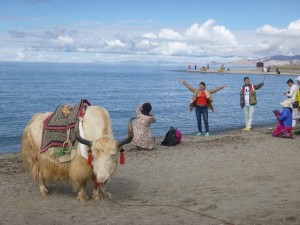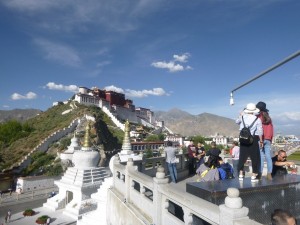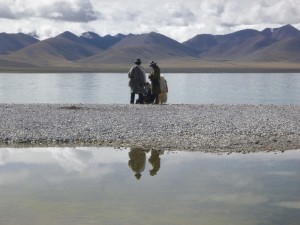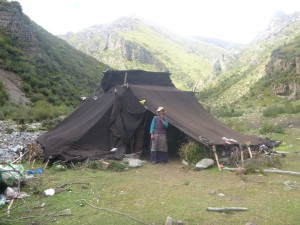 The Potala Palace, known the world over as an icon of Tibetan Buddhism, towered over the city of Lhasa casting a literal shadow on the hustle and bustle below. Although from our vantage point, the profound symbolism of the building was lost amidst the chaos of modernity that swarmed below it. As we stood in awe of the structure that inspired us to make the trip to Tibet in the first place, we couldn’t help but be a little perplexed by the situation staring back up at it.
The Potala Palace, known the world over as an icon of Tibetan Buddhism, towered over the city of Lhasa casting a literal shadow on the hustle and bustle below. Although from our vantage point, the profound symbolism of the building was lost amidst the chaos of modernity that swarmed below it. As we stood in awe of the structure that inspired us to make the trip to Tibet in the first place, we couldn’t help but be a little perplexed by the situation staring back up at it.
Like a rock concert full of screaming fans thrusting their lighters in the air, we stood in a sea of smart phones and selfie-sticks all competing for the best picture in front of the great Potala. Tour groups draped in the latest hiking gear, teenage girls trying desperately to fit their entire entourage within the frame of a smartphone and even professional wedding photography in traditional Tibetan attire…being worn by non-Tibetans. What had become of this icon of Buddhist spirituality? Was our image of the Potala really that misaligned with its reality?
 SOMETHING, SOMEWHERE WENT HORRIBLY WRONG:
SOMETHING, SOMEWHERE WENT HORRIBLY WRONG:
Nearly seventy years ago Tibet lost its political sovereignty at the hands of the Peoples Republic of China, in what was one of the century’s most brutal military occupations. And since then, Tibet has undergone a systematic cultural infiltration by Han Chinese immigrants, backed by the Chinese government.
This influx has lead to the gradual modernization of Tibet (Roads, schools and industry) but at the cost of their cultural identity. These days any visit to Tibet is not without the shocking realization that much of the country is essentially a Chinatown with their signature grey high-rises, wide boulevards and tacky storefronts, surrounding what is typically only a small Tibetan Quarter.
Modern day Tibet is without a doubt and eye-opening experience, but maybe not in the way you would expect. Foreign tourists are required to navigate a lengthy process of permits, government approved guides, vehicles and restricted areas. All this while the Chinese tourists and immigrants are given a free pass.
 To add fuel to the fire, the new Chinese middle class has developed a taste for travel. So with a weak currency, a limited command of the English language and a limit to how much Yuan they can take out of the country per year, many Chinese prefer to travel domestically rather than abroad. All these reasons and more contribute to the mass Chinese tourism that has now become a hallmark to China.
To add fuel to the fire, the new Chinese middle class has developed a taste for travel. So with a weak currency, a limited command of the English language and a limit to how much Yuan they can take out of the country per year, many Chinese prefer to travel domestically rather than abroad. All these reasons and more contribute to the mass Chinese tourism that has now become a hallmark to China.
ALL IS NOT LOST!
 Despite continued oppression from the Chinese government and the influx of Chinese tourists, Tibetans have managed to keep their traditions intact and very much alive. And for those travelers willing to work for it, there are still many treks, temples, villages, valleys and monasteries that are truly and utterly Tibetan. It is still possible to visit traditional nomads, hike trough remote valleys and find yourself completely alone (aside from your mandatory guide) in an isolated Tibetan monastery. Yes, all these things still exist in modern day Tibet and since most Chinese tourists stick to well trodden paths and most foreign tourists are scared off by all the permits and restrictions, they can be all yours….with a little research and planning of course!
Despite continued oppression from the Chinese government and the influx of Chinese tourists, Tibetans have managed to keep their traditions intact and very much alive. And for those travelers willing to work for it, there are still many treks, temples, villages, valleys and monasteries that are truly and utterly Tibetan. It is still possible to visit traditional nomads, hike trough remote valleys and find yourself completely alone (aside from your mandatory guide) in an isolated Tibetan monastery. Yes, all these things still exist in modern day Tibet and since most Chinese tourists stick to well trodden paths and most foreign tourists are scared off by all the permits and restrictions, they can be all yours….with a little research and planning of course!
TIPS AND TRICKS:
1. Keep your expectations realistic! The Han Chinese are a real presence in Tibet, so don’t expect to find your Shangri-La right out of the airport.
2. Work with a tour company to customize your own itinerary prior to leaving. Yes, this part will take some research.
3. Get off the beaten track. Go to places that aren’t “Must Sees” as they will be filled with smartphones and selfie-sticks.
4. Remember, Tibet is expensive so plan accordingly. Although your (mandatory) tour company should have most costs covered in their price.
Chinese youth have taken a serious liking to Tibet, and these days Tibet is seen as an inspiring and exotic location within their own borders. It’s safe to say that the young Chinese of today have different attitudes about Tibet compared with previous generations. So as Tibetan youths grow up and assume positions of power within their government we can only hope that they carry forward their more “enlightened” views of the Tibetan Plateau and give back to Tibet its much deserved autonomy and civil liberties.


